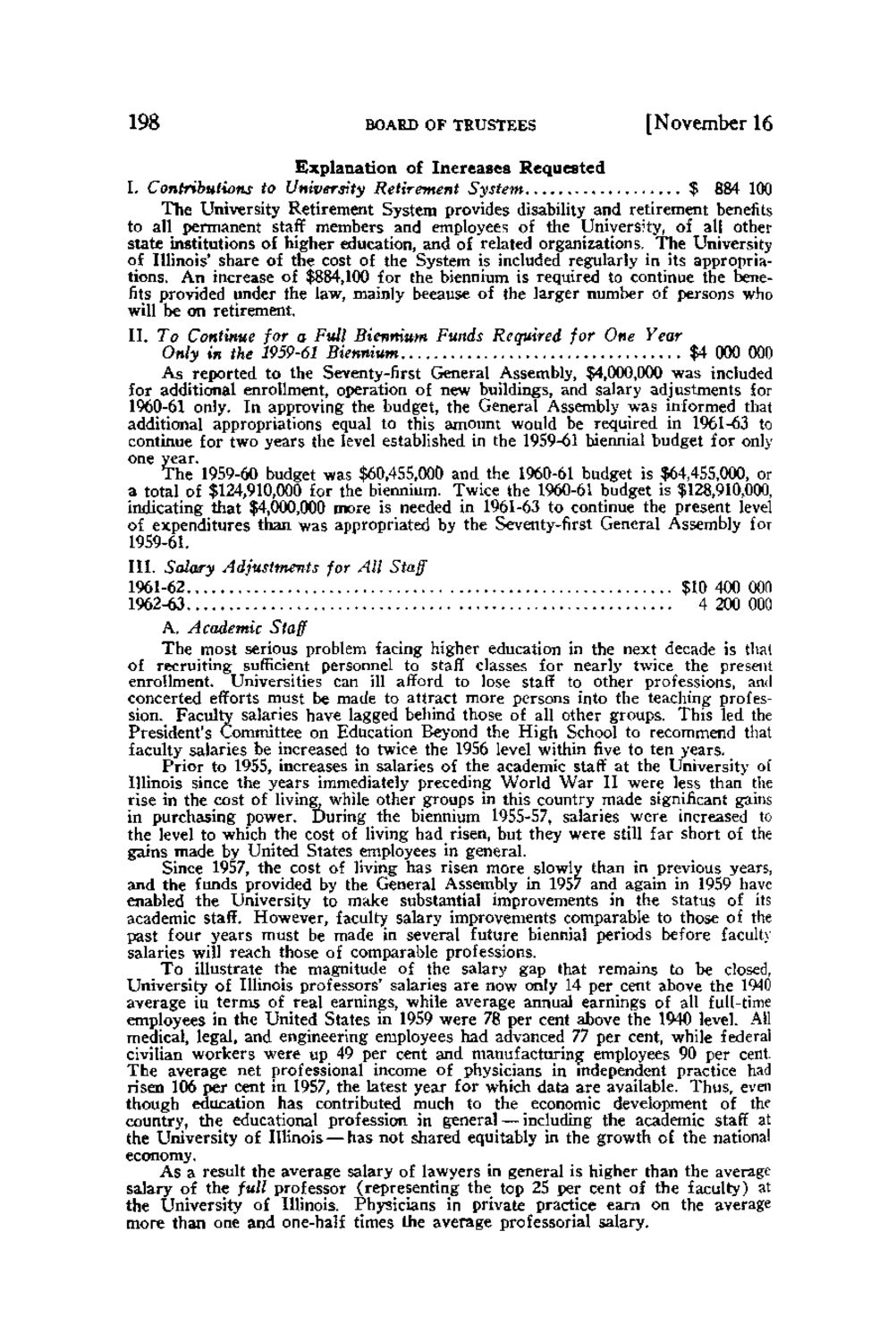| |
| |
Caption: Board of Trustees Minutes - 1962
This is a reduced-resolution page image for fast online browsing.

EXTRACTED TEXT FROM PAGE:
198 BOARD OF TRUSTEES [November 16 Explanation of Increases Requested I. Contributions to University Retirement System $ 884 100 The University Retirement System provides disability and retirement benefits to all permanent staff members and employees of the University, of all other state institutions of higher education, and of related organizations. The University of Illinois' share of the cost of the System is included regularly in its appropriations. An increase of $884,100 for the biennium is required to continue the benefits provided under the law, mainly because of the larger number of persons who will be on retirement, II. To Continue for a Full Biennium Funds Required for One Year Only in the 1959-61 Biennium $4 000 000 As reported to the Seventy-first General Assembly, $4,000,000 was included for additional enrollment, operation of new buildings, and salary adjustments for 1960-61 only. In approving the budget, the General Assembly was informed that additional appropriations equal to this amount would be required in 1961-63 to continue for two years the level established in the 1959-61 biennial budget for only one year. The 1959-60 budget was $60,455,000 and the 1960-61 budget is $64,455,000, or a total of $124,910,000 for the biennium. Twice the 1960-61 budget is $128,910,000, indicating that $4,000,000 more is needed in 1961-63 to continue the present level of expenditures than, was appropriated by the Seventy-first General Assembly for 1959-61. III. Salary Adjustments for All Staff 1961-62 $10 400 000 4 200 000 1962-63 A, Academic Staff The most serious problem facing higher education in the next decade is that of recruiting sufficient personnel to staff classes for nearly twice the present enrollment. Universities can ill afford to lose staff to other professions, and concerted efforts must be made to attract more persons into the teaching profession. Faculty salaries have lagged behind those of all other groups. This led the President's Committee on Education Beyond the High School to recommend that faculty salaries be increased to twice the 1956 level within five to ten years. Prior to 1955, increases in salaries of the academic staff at the University of Illinois since the years immediately preceding World War II were less than the rise in the cost of living, while other groups in this country made significant gains in purchasing power. During the biennium 1955-57, salaries were increased to the level to which the cost of living had risen, but they were still far short of the gains made by United States employees in general. Since 1957, the cost of living has risen more slowly than in previous years, and the funds provided by the General Assembly in 195/ and again in 1959 have enabled the University to make substantial improvements in the status of its academic staff. However, faculty salary improvements comparable to those of the past four years must be made in several future biennial periods before faculty salaries will reach those of comparable professions. To _ illustrate the magnitude of the salary gap that remains to be closed, University of Illinois professors' salaries are now only 14 per cent above the 1940 average iu terms of real earnings, while average annual earnings of all full-time employees in the United States in 1959 were 78 per cent above the 1940 level. Ail medical, legal, and engineering employees had advanced 77 per cent, while federal civilian workers were up 49 per cent and manufacturing employees 90 per cent The average net professional income of physicians in independent practice had risen 106 per cent in 1957, the latest year for which data are available. Thus, even though education has contributed much to the economic development of the country, the educational profession in general — including the academic staff at the University of Illinois—has not shared equitably in the growth of the national economy. As a result the average salary of lawyers in general is higher than the average salary of the full professor {representing the top 25 per cent of the faculty) at the University of Illinois. Physicians in private practice earn on the average more than one and one-half times Ihe average professorial salary.
| |